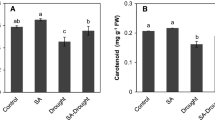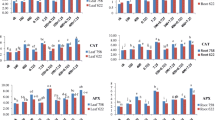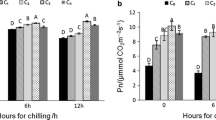Abstract
The effects of salicylic acid (SA) pretreatment on ascorbate–glutathione (GSH) cycle under chilling stress in eggplant seedlings were investigated. Salicylic acid pretreatment improved chilling resistance of eggplant seedlings with maximum efficiency at a concentration of 0.3%. The chilling injury index was decreased by 36.9% as compared to that of the control after 0.3% SA pretreatment. Under chilling stress, seedlings pretreated with SA displayed lower hydrogen peroxide (H2O2) content and higher ascorbate peroxidase (APX) activity than the untreated seedlings. Pretreatment with SA increased ascorbic acid and GSH content. Salicylic acid (0.3%) pretreatment enhanced the dehydroascorbate reductase (MDHAR) and dehydroascorbate reductase (DHAR) activity but not glutathione reductase (GR). Pretreatment with SA also enhanced the induced expression of stress-responsive genes under chilling stress. The highest transcript levels of GST1, GST2, GPX1, GPX2, GSH, MDHAR, GR and DHAR upon pretreatment with SA (0.3%) were 6.21, 6.24, 7.76, 5.99, 6.54, 6.44, 2.86 and 2.15 folds, respectively as compared to non-SA-treated seedlings. Taken together, SA pre-treatment could effectively protect eggplant seedlings from oxidative damage of chilling stress through enhancing antioxidant enzymes activities and related gene expression.




Similar content being viewed by others
References
Adriano S, Angelo CT, Bartolomeo D, Cristos X (2005) Influence of water deficit and rewatering on the components of the ascorbate–glutathione cycle in four interspecific Prunus hybrids. Plant Sci 169:403–412
Bai TH, Li CY, Ma FW, Shu HR, Han MY (2009) Exogenous salicylic acid alleviates growth inhibition and oxidative stress induced by hypoxia stress in Malus robusta Rehd. J Plant Growth Regul 28:358–366
Bernard F, Shaker-Bazarnov H, Kavian BI (2002) Effects of salicylic acid on cold preservation and cryopreservation of encapsulated embryonic axes of Persian lilac (Melia azedarachi L.). Euphytica 123:85–88
Blokhina O, Virolainen E, Fagerstedt KV (2003) Antioxidants, oxidative damage and oxygen deprivation stress: a review. Ann Bot 91:179–194
Brennan T, Frenkel C (1977) Involvement of hydrogen-peroxide in regulation of senescence in pear. Plant Physiol 59:411–416
Catinot J, Buchala A, Abou-Mansour E, Métraux JP (2008) Salicylic acid production in response to biotic and abiotic stress depends on isochorismate in Nicotiana benthamiana. FEBS Lett 582:473–478
Ding CK, Wang CY, Gross KC, Smith DL (2002) Jasmonate and salicylate induce the expression of pathogenesis-related-protein genes and increase resistance to chilling injury in tomato fruit. Planta 214:895–901
Faltin Z, Holland D, Velcheva M, Tsapovetsky M, Roeckel-Drevet P, Handa AK, Abu-Abied M, Friedman-Einat M, Eshdat Y, Perl A (2010) Glutathione peroxidase regulation of reactive oxygen species level is crucial for in vitro plant differentiation. Plant Cell Physiol 51:1151–1162
Foyer CH, Halliwell B (1976) The presence of glutathione and glutathione reductase in chloroplasts: a proposed role in ascorbic acid metabolism. Planta 133:21–25
Guo B, Liang YC, Zhu YG, Zhao FJ (2007) Role of salicylic acid in alleviating oxidative damage in rice roots (Oryza sativa) subjected to cadmium stress. Environ Pollut 47:743–749
Hernandez JA, Ferrer MA, Jime′nez A, Barcelo′ AR, Sevilla F (2001) Antioxidant systems and O2 -/H2O2 production in the apoplast of pea leaves. Its relation with salt-induced necrotic lesions in minor veins. Plant Physiol 127:817–831
Horváth E, Szalai G, Janda T (2007) Induction of abiotic stress tolerance by salicylic acid signaling. J Plant Growth Regul 26:290–300
Janda T, Szalai G, Tari I, Paldi E (1999) Hydroponic treatment with salicylic acid decreases the effects of chilling injury in maize (Zea mays L.) plants. Planta 208:175–180
Kampfenkel K, Van MM, Inze D (1995) Extraction and determination of ascorbate and dehydroascorbate from plant tissue. Anal Biochem 225:165–167
Kang GZ, Wang ZX, Sun GC (2003a) Participation of H2O2 in enhancement of cold chilling by salicylic acid in banana seedlings. Acta Bot Sin 45:567–573
Kang GZ, Wang CH, Sun GC, Wang ZX (2003b) Salicylic acid changes activities of H2O2-metabolizing enzymes and increases the chilling tolerance of banana seedlings. Environ exp Bot 50:9–15
Kaur G, Basra AS, Basra RK, Kaur O, Asthir B (2008) Thermotolerance induced by heat acclimation and salicylic acid in Mungbean (Vigna radiata L.) seedlings. Environ Ecol 26:598–601
Lei T, Feng H, Sun X, Dai QL, Zhang F, Liang HG, Lin HH (2010) The alternative pathway in cucumber seedlings under low temperature stress was enhanced by salicylic acid. Plant Growth Regul 60:35–42
Livak KJ, Schmittgen TD (2001) Analysis of relative gene expression data using real-time quantitative PCR and the 2−ΔΔCT method. Methods 25:402–408
Ma YH, Ma FW, Zhang JK, Li MY, Wang YH, Liang D (2008) Effects of high temperature on activities and gene expression of enzymes involved in ascorbate–glutathione cycle in apple leaves. Plant Sci 175:761–766
Nakano Y, Asada K (1987) Purification of ascorbate peroxidase in spinach chloroplasts: its inactivation in ascorbate-depleted medium and reactivation by monodehydroascorbate radical. Plant Cell Physiol 28:131–140
Orozco-Cárdenas ML, Ryan CA (1999) Hydrogen peroxide is generated systematically in plant leaves by wounding and systemin via the octadecanoid pathway. Proc Natl Acad Sci USA 96:6553–6557
Prabhavathi VR, Rajam MV (2007) Polyamine accumulation in transgenic eggplant enhances tolerance to multiple abiotic stresses and fungal resistance. Plant Biotechnol J 24:273–282
Smith I (1985) Stimulation of glutathione synthesis in photorespiring plants by catalase inhibitors. Plant Physiol 79:1044–1047
Snyman M, Cronjé MJ (2008) Modulation of heat shock factors accompanies salicylic acid-mediated potentiation of Hsp70 in tomato seedlings. J Exp Bot 59:2125–2132
Szalai G, Tari I, Janda T, Pestenacz A, Paldi E (2002) Effects of cold acclimation and salicylic acid on changes in ACC and MACC contents in maize during chilling. Biol Plantarum 43:637–640
Taşgın E, Ökkeş A, Nalbantoğlu B, Popova LP (2006) Effects of salicylic acid and cold treatments on protein levels and on the activities of antioxidant enzymes in the apoplast of winter wheat leaves. Phytochemistry 67:710–715
Wang FH, Gao WN, Lin DQ (2006) Influence of Ca2+ on protein content and specific protein of eggplant seedling under cold stress. J Henan Agric Sci 6:86–88
Wang DH, Li XX, Su ZK, Ren HX (2009a) The role of salicylic acid in response of two rice cultivars to chilling stress. Biol Plantarum 53:545–552
Wang L, Chen WJ, Wang Q, Eneji AE, Li ZH, Duan LS (2009b) Coronatine enhances chilling tolerance in cucumber (Cucumis sativus L.) seedlings by improving the antioxidative defence system. J Agron Crop Sci 195:377–383
Xia XJ, Wang YJ, Zhou YH, Tao Y, Mao W-H, Shi K, Asami T, Chen ZX, Yu JQ (2009) Reactive oxygen species are involved in brassinosteroid-induced stress tolerance in cucumber. Plant Physiol 150:801–814
Yang YN, Min Q, Mei CS (2004) Endogenous salicylic acid protects rice plants from oxidative damage caused by aging as well as biotic and abiotic stress. Plant J 40:909–919
Zawoznik MS, Groppa MD, Tomaro ML, Benavides MP (2007) Endogenous salicylic acid potentiates cadmium-induced oxidative stress in Arabidopsis thaliana. Plant Sci 173:190–197
Acknowledgments
This work was supported by National Basic Research Program of China (2009CB119000), National Key Technology R&D Program during the 12th Five-Year Plan Period (2011BAD12B03) and China Postdoctoral Science Foundation (20090461397). We also thank Adrian Slater and the two anonymous referees for their invaluable comments and suggestions.
Author information
Authors and Affiliations
Corresponding author
Rights and permissions
About this article
Cite this article
Chen, S., Zimei, L., Cui, J. et al. Alleviation of chilling-induced oxidative damage by salicylic acid pretreatment and related gene expression in eggplant seedlings. Plant Growth Regul 65, 101–108 (2011). https://doi.org/10.1007/s10725-011-9579-9
Received:
Accepted:
Published:
Issue Date:
DOI: https://doi.org/10.1007/s10725-011-9579-9




